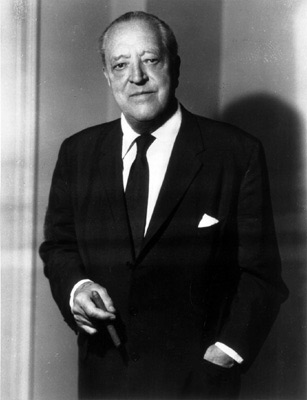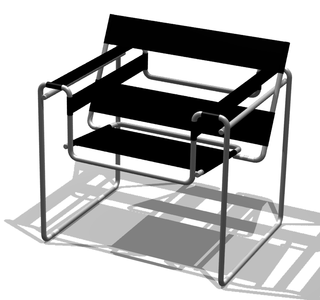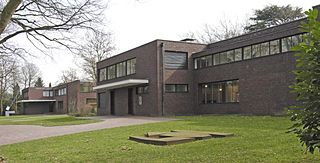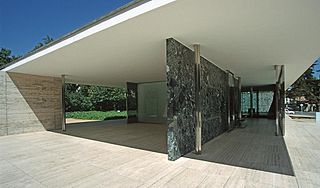
The Staatliches Bauhaus, commonly known as the Bauhaus, was a German art school operational from 1919 to 1933 that combined crafts and the fine arts. The school became famous for its approach to design, which attempted to unify individual artistic vision with the principles of mass production and emphasis on function. Along with the doctrine of functionalism, the Bauhaus initiated the conceptual understanding of architecture and design.

Ludwig Mies van der Rohe was a German-American architect, academic, and interior designer. He was commonly referred to as Mies, his surname. He is regarded as one of the pioneers of modern architecture.

Villa Tugendhat is an architecturally significant building in Brno, Czech Republic. It is one of the pioneering prototypes of modern architecture in Europe, and was designed by the German architects Ludwig Mies van der Rohe and Lilly Reich. It was built between 1928 and 1930 for Fritz Tugendhat and his wife Greta, of the wealthy and influential Jewish Czech Tugendhat family. Of reinforced concrete, the villa soon became an icon of modernism. Famous for its revolutionary use of space and industrial building materials, the building was added to the UNESCO World Heritage List in 2001.

The Barcelona Pavilion, designed by Ludwig Mies van der Rohe and Lilly Reich, was the German Pavilion for the 1929 International Exposition in Barcelona, Spain. This building was used for the official opening of the German section of the exhibition. It is an important building in the history of modern architecture, known for its simple form and its spectacular use of extravagant materials, such as marble, red onyx and travertine. Furnishings specifically designed for the building, including the Barcelona chair, are still in production. It has inspired many important modernist buildings. The original structure was demolished in 1930, and the existing reconstruction was completed in 1986.

In architecture, functionalism is the principle that buildings should be designed based solely on their purpose and function. An international functionalist architecture movement emerged in the wake of World War I, as part of the wave of Modernism. Its ideas were largely inspired by a desire to build a new and better world for the people, as broadly and strongly expressed by the social and political movements of Europe after the extremely devastating world war. In this respect, functionalist architecture is often linked with the ideas of socialism and modern humanism.

Florence Marguerite Knoll Bassett was an American architect, interior designer, furniture designer, and entrepreneur who has been credited with revolutionizing office design and bringing modernist design to office interiors. Knoll and her husband, Hans Knoll, built Knoll Associates into a leader in the fields of furniture and interior design. She worked to professionalize the field of interior design, fighting against gendered stereotypes of the decorator. She is known for her open office designs, populated with modernist furniture and organized rationally for the needs of office workers. Her modernist aesthetic was known for clean lines and clear geometries that were humanized with textures, organic shapes, and colour.

The Brno chair is a modernist cantilever chair designed by Ludwig Mies van der Rohe and Lilly Reich in 1929-1930 for the bedroom of the Tugendhat House in Brno, Czech Republic. The design was based on similar chairs created by Mies van der Rohe working with Lilly Reich, such as the MR20 chair with wicker seat from 1927; all building on earlier designs of Mart Stam.

The Tugendhat chair is a modernist cantilever chair designed by Ludwig Mies van der Rohe in collaboration with Lilly Reich 1929-1930 for the Tugendhat House in Brno, Czechoslovakia.

Lilly Reich was a German designer of textiles, furniture, interiors, and exhibition spaces. She was a close collaborator with Ludwig Mies van der Rohe for more than ten years during the Weimar period from 1925 until his emigration to the U.S. in 1938. Reich was an important figure in the early Modern Movement in architecture and design. Her fame was posthumous, as the significance of her contribution to the work of Mies van der Rohe and others with whom she collaborated with only became clear through the research of later historians of the field.

The bubble chair was designed by Finnish furniture designer Eero Aarnio in 1968. It is based on his Ball Chair. The main difference is that the Bubble Chair is attached to the ceiling with a chain, while being made of transparent material which lets the light inside from all directions. The acrylic is heated and blown into a round shape like a soap bubble, within a solid steel frame. It is considered an industrial design classic and to have advanced the usage of plastics in furniture design. The chair is considered modernist or Space Age in design and is often used to symbolize the 1960s period.

Modern furniture refers to furniture produced from the late 19th century through the present that is influenced by modernism. Post-World War II ideals of cutting excess, commodification, and practicality of materials in design heavily influenced the aesthetic of the furniture. It was a tremendous departure from all furniture design that had gone before it. There was an opposition to the decorative arts, which included Art Nouveau, Neoclassical, and Victorian styles. Dark or gilded carved wood and richly patterned fabrics gave way to the glittering simplicity and geometry of polished metal. The forms of furniture evolved from visually heavy to visually light. This shift from decorative to minimalist principles of design can be attributed to the introduction of new technology, changes in philosophy, and the influences of the principles of architecture. As Philip Johnson, the founder of the Department of Architecture and Design at the Museum of Modern Art articulates:
"Today industrial design is functionally motivated and follows the same principles as modern architecture: machine-like simplicity, smoothness of surface, avoidance of ornament ... It is perhaps the most fundamental contrast between the two periods of design that in 1900 the Decorative Arts possessed ..."
Hans G. Knoll (1914–1955) was a German-American who, together with his wife, Florence Knoll, founded Knoll, the well-known design company and furniture manufacturer.

Knoll is an American company that manufactures office systems, seating, storage systems, tables, desks, textiles, and accessories for the home, office, and higher education. The company is the licensed manufacturer of furniture designed by architects and designers such as Harry Bertoia, Ludwig Mies van der Rohe, Florence Knoll, Frank Gehry, Charles Gwathmey, Maya Lin, Marcel Breuer, Eero Saarinen, and Lella and Massimo Vignelli, under the company's KnollStudio division. Over 40 Knoll designs can be found in the permanent design collection of the Museum of Modern Art in New York City.
Jan Ruhtenberg was an architect who "made significant contributions in introducing modern architecture to the United States as a teacher and a modern architect".
Hans Bellmann (1911–1990) was a Swiss furniture designer primarily active in the 1950s and 1960s. He designed furniture for companies such as Knoll and Horgen-Glarus.

Haus Lange and Haus Esters are two residential houses designed by Ludwig Mies van der Rohe in Krefeld, Germany, for German industrialists Hermann Lange and Josef Esters. They were built between 1928 and 1930 in the Bauhaus style. The houses have now been converted into museums for Contemporary art.
The Gane Pavilion, also known as Gane's Pavilion, the Gane Show House and the Bristol Pavilion, was a temporary building designed by the modernist architect and furniture designer Marcel Breuer with F. R. S. Yorke and built in 1936 at Ashton Court near Bristol in England.

Eduard Ludwig was a German architect. He was a student at the Bauhaus design school and later worked with notable architects from the school. He designed the Berlin Airlift Monument in Platz der Luftbrücke, Berlin.

A pavilion is a genre of building often found at large international exhibitions such as a World's fair. It may be designed by a well-known architect or designer from the exhibiting country to showcase the latest technology of the exhibitor or be designed in what is considered the national architectural style of the exhibiting country. The German pavilion for the 1929 Barcelona International Exposition, for instance, was designed by noted modernist German architects Ludwig Mies van der Rohe and Lilly Reich.

The Weissenhof chair is a chair designed by the German architect and designer Ludwig Mies van der Rohe, in 1927. This first, springy cantilever chair was shown at the Weissenhofsiedlung Exhibition in 1927. It was made of 25 mm steel tube and with a wicker framework proposed by Lilly Reich. The MR20 version has forearms.





















